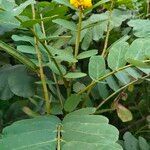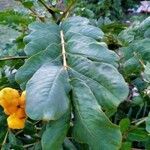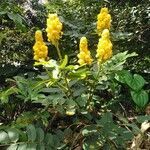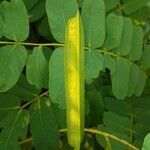Shrub 1 — 2( — 5) m; branches thick, pubescent. Stipules auriculate-deltoid, 6 — 10( — 15) mm, persistent, brownish red. Leaves with 8-20 pairs of leaflets; petiole robust, 2-3 cm; rachis 30-60 cm. Leaflets oblong-elliptic, 5-15 by 3-7 cm, obtuse at both ends, glabrous. Racemes axillary, dense, robust, many-flowered, 20-50 by 3-4 cm; peduncle stout, 7-14 cm; bracts strobilate, at first enveloping the flowers, broadly ovate, caducous, 2-3 by 1-2 cm; pedicels 5-10 mm. Sepals orange-yellow, oblong, unequal, 10-20 by 6-7 mm. Petals bright yellow, ovate-orbicular, 16-24 by 10-15 mm, short-clawed. Stamens: 2 large with stout filaments, 4 mm long and anthers 12-13 mm opening with apical pores; 4 with filaments 2 mm long and anthers 4-5 mm opening by apical pores; reduced stamens 3 or 4. Ovary puberulous, pruinose, sessile, ovules many (up to c. 58); style filiform; stigma small. Pods sharply tetragonal, winged, glabrous, black, 10-15 by 1.5-2 cm, wings 4-8 mm. Seeds up to c. 50, shining, flattened, quadrangular, 7-8 by 5-8 mm.
Shrub, spreading, to 3 m high, pubescent on vegetative parts, inflorescence axes and ovary, otherwise glabrous. Leaves 15–40 cm long including a terete petiole 20–40 mm long; stipules cordate, subpersistent; leaflets in 8–12 pairs spaced 10–20 mm apart, oblong, 80–110 mm long, 30–55 mm wide, increasing distally, obtuse and mucronate or emarginate; glands absent. Inflorescence dense, of 20–40 flowers, axillary; peduncle 15–30 cm long; pedicels 5–8 mm long; bracts orange, caducous. Petals to 20 mm long. Fertile stamens 2, with 7 adaxial and 1 abaxial staminodes; filaments unequal, 2–4 mm long; fertile anthers c. 4 mm long. Pod compressed-cylindric, 12–16 cm long, 10–15 mm wide, straight or curved, each valve with a median wing c. 6 mm wide. Seeds dull.
A shrub which loses its leaves during the year. It grows to 1-6 m high and spreads to 2 m across. The stem is erect and slender. The young stems are finely hairy. The leaves are large and oblong. They are divided into 8-14 pairs of leaflets. These are oblong and 5-19 cm long by 2.5-12 cm wide. They are usually blunt at the top. The flowers are yellow. They occur in spike-like clusters. These are 15-70 cm long. The fruit are winged pods. They are black and 12-17 cm long, with the central part 1.5-2 cm wide. The pod has partitions across it. The edge of the wing is wavy. The seeds are oval with a beak. They are 6-8 mm long and 4-5 mm wide. There are 2 shiny green patches near the beak.










